Who says your garden has to be green?
-
One of the quickest ways to make your garden more interesting and dramatic is to choose plants with unusual leaf colors. That's because it's the leaves of your plants that you see all the time and that make a lasting impact. Flowers are simply a short-term bonus. They are just visitors.
Remember: flowers are fleeting, but leaves are lasting.
Not every plant has to have leaves that pop, of course. In fact, mixing leaf colors is a bit like matching clothes: too much and you end up looking like a clown. No plaids next to polka dots for you. Your garden should contain a solid backbone of green, with tastefully colorful accents to keep it from being blah. Think of colorful leaves as the exclamation points of your garden. An exclamation point used sparingly is good, but too many can make your space busy.
The next time you're at the nursery, try to challenge yourself to avoid looking at flowers. Focus on the leaves instead. Will that yellow-leaved Spirea juxtapose nicely with your Hellebores? Will that burgundy Heuchera make your pathway pop? Would a small blue succulent look killer in the middle of your herbs? Of course, don't forget to choose plants that work for your climate and your exposure (sun, half-sun, shade). That dark purple Japanese maple may look stunning at the nursery, but if it needs shade it's going to fry on your exposed south-facing slope.
Here are a few plants to check out while you're at the nursery. Do you have a home for one of these colorful additions?
Basic black
Like that perfect little black cocktail dress, Sambucus 'Black Lace' really dresses up your garden. This shrub, a relative of the common elderberry, will probably look less intensely black if it is in blasting sun, so tuck it into a dappled-light corner. Its leaves truly look like black lace, deeply cut and practically frilly. This shrub can get up to 10 feet tall, so don't be afraid to use it in the background of your garden.
Physocarpus opulifolius 'Diablo', or ninebark, is another brunette beauty. This shrub has deep purple-black leaves that turn brownish purple when the weather warms up in summer. Extremely hot weather may cause it to green up a bit. Similarly, Ceanothus 'tuxedo' has nearly black foliage. Unlike our native Ceanothus, this plant will require some summer water. Give it full sun and good drainage for its dark foliage to shine.
The wonder of white
From fragrant Artemesias to common dusty millers, white is a winner. It's bright and ultra-contrasty, so a little goes a long way. Check out the very white and very unique Centaurea gymnocarpa if you want to see an ultra-white plant. Its leaves are felt-like and divided. Give this two-foot tall shrub room to spread out or plan on regularly nipping at its white arms, since it will spread out beyond five feet.Another white contender is Salvia apiana, our native white sage. This evergreen -- or everwhite -- shrub grows to around three or four feet tall and sends up spikes of bee-loving flowers. This is the plant that our Native American predecessors used for smudge sticks. It is intensely fragrant, unusual, and beautiful in an earthy way.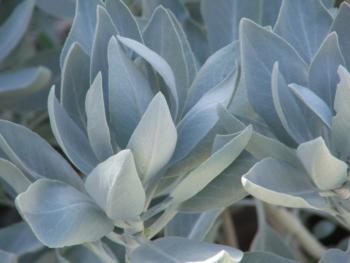 The silky white beauty of Salvia apiana. (Photo courtesy of Las Pilitas Nursery)Some whites are more subtle, leaning almost toward yellow. These include the Carex (Sedge) family of grass-like plants which come in a variety of variegation. Carex morrowii 'aurea-Variegata' is an excellent choice for cooler, shadier spots that need some brightening up. This bunch grass has thin arching leaves that are medium green with a bright yellowish-white stripe down the center of each blade. On a half-lit pathway, this plant serves as a little flashlight.
The silky white beauty of Salvia apiana. (Photo courtesy of Las Pilitas Nursery)Some whites are more subtle, leaning almost toward yellow. These include the Carex (Sedge) family of grass-like plants which come in a variety of variegation. Carex morrowii 'aurea-Variegata' is an excellent choice for cooler, shadier spots that need some brightening up. This bunch grass has thin arching leaves that are medium green with a bright yellowish-white stripe down the center of each blade. On a half-lit pathway, this plant serves as a little flashlight.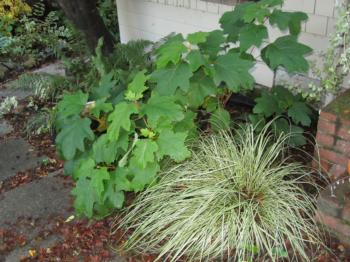 A yellow-white-striped Carex grass and large-leaved Oak Leaf Hydrangea. (Photo: Marie Narlock)
A yellow-white-striped Carex grass and large-leaved Oak Leaf Hydrangea. (Photo: Marie Narlock)You can't beat the blues
Blue is in, from the low tubular Senecio succulents to the cultivars that come from our native Festuca grasses. Check out Festuca glauca 'Elijah Blue', a diminutive grass that you can tuck in almost anywhere. Intense sun will bleach out the blues a bit, so find a dappled light spot for this low bunch grass. Helictotrichon sempervirens, or blue oat grass, is a larger and more common blue grass. This is an excellent everblue addition to any border.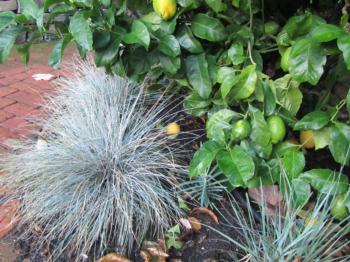 Spiky blue fescue grasses contrast with large green citrus leaves. (Photo: Marie Narlock)
Spiky blue fescue grasses contrast with large green citrus leaves. (Photo: Marie Narlock)Brilliant burgundy
Step aside, Japanese Maples, because there are a whole host of other red-leaved contenders out there. For hot dry sites, it's hard to beat the Cotinus family. These shrubs or small trees, commonly called smoke bush due to their unusual flowers, come in an array of dark-leaved colors, from the intensely dark 'Velvet Cloak' to the larger-leaved 'Grace'. They are easy and fast-growing, thriving in iffy soil and, once established, little water.
For lower-growing deep burgundy accents, there are many Heuchera, or coral bells, from which to choose. Coral bells come in a multitude of leaf colors, all growing to around two feet tall. Once you get to know this plant you will be hooked. Besides, how can you resist a coral bell called 'Cathedral Windows', 'Chocolate Veil', 'Velvet Night', or 'Palace Purple'?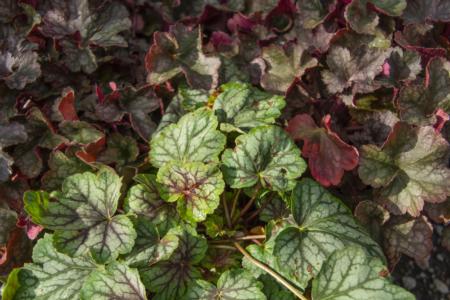 Coral bells come in a variety of colors. (Photo: Marybeth Kampman)
Coral bells come in a variety of colors. (Photo: Marybeth Kampman)Another excellent low-growing burgundy plant is the succulent Aeonium arboreum 'Atropurpureum'. Gardeners have glommed on to the beauty and climate-appropriateness of succulents, which demand little water and provide intense color and texture. Nurseries carry an increasing number of these low-stress plants which are sure to create instant interest to your garden or windowsill.
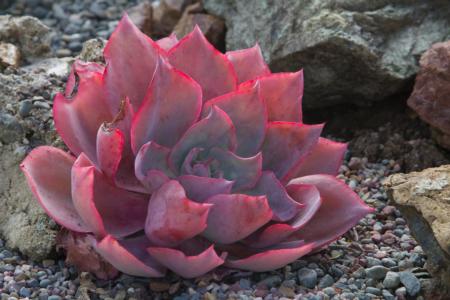 Succulents add instant color and texture to the garden. (Photo: Dorothy Weaver)
Succulents add instant color and texture to the garden. (Photo: Dorothy Weaver)
By Marie Narlock





